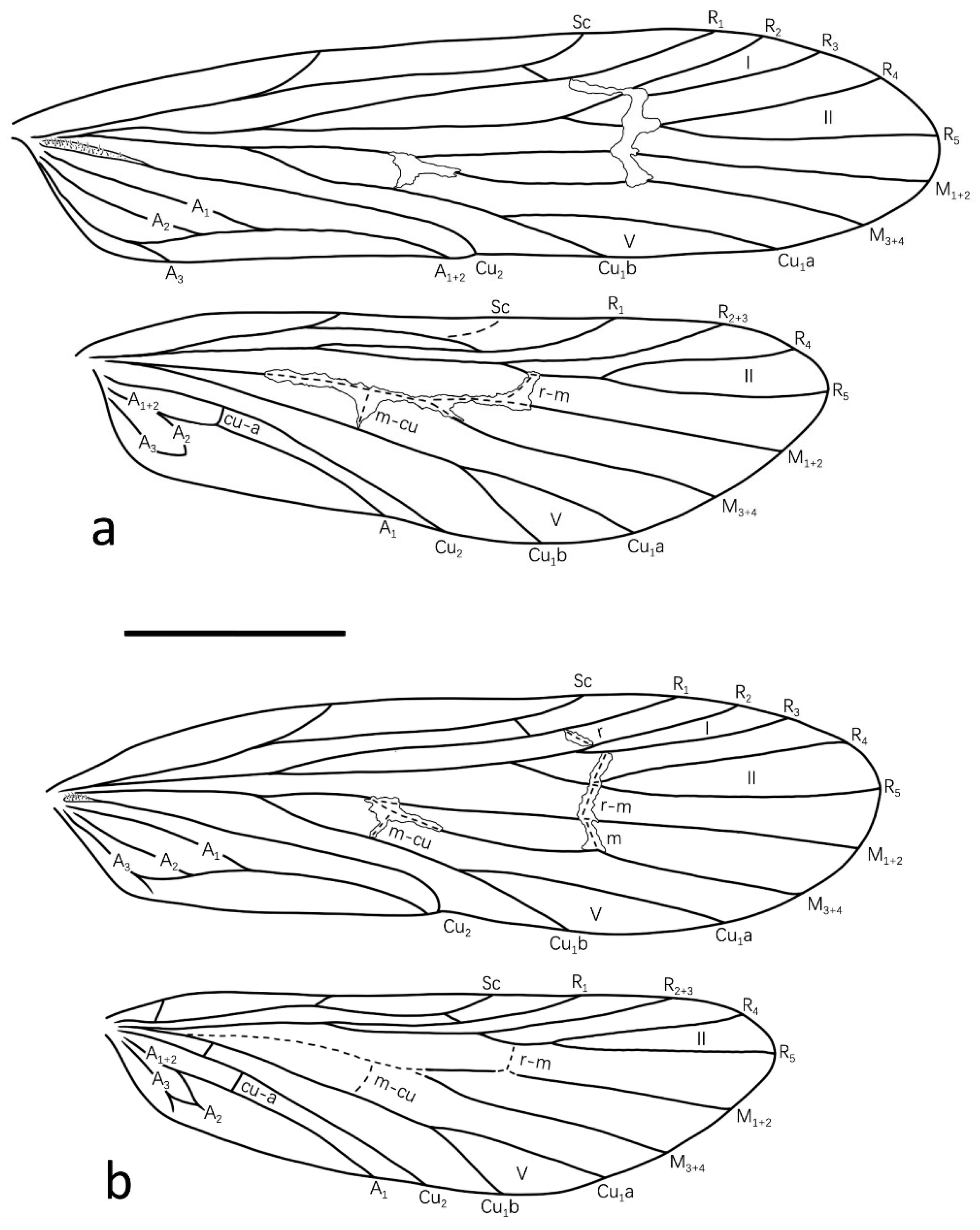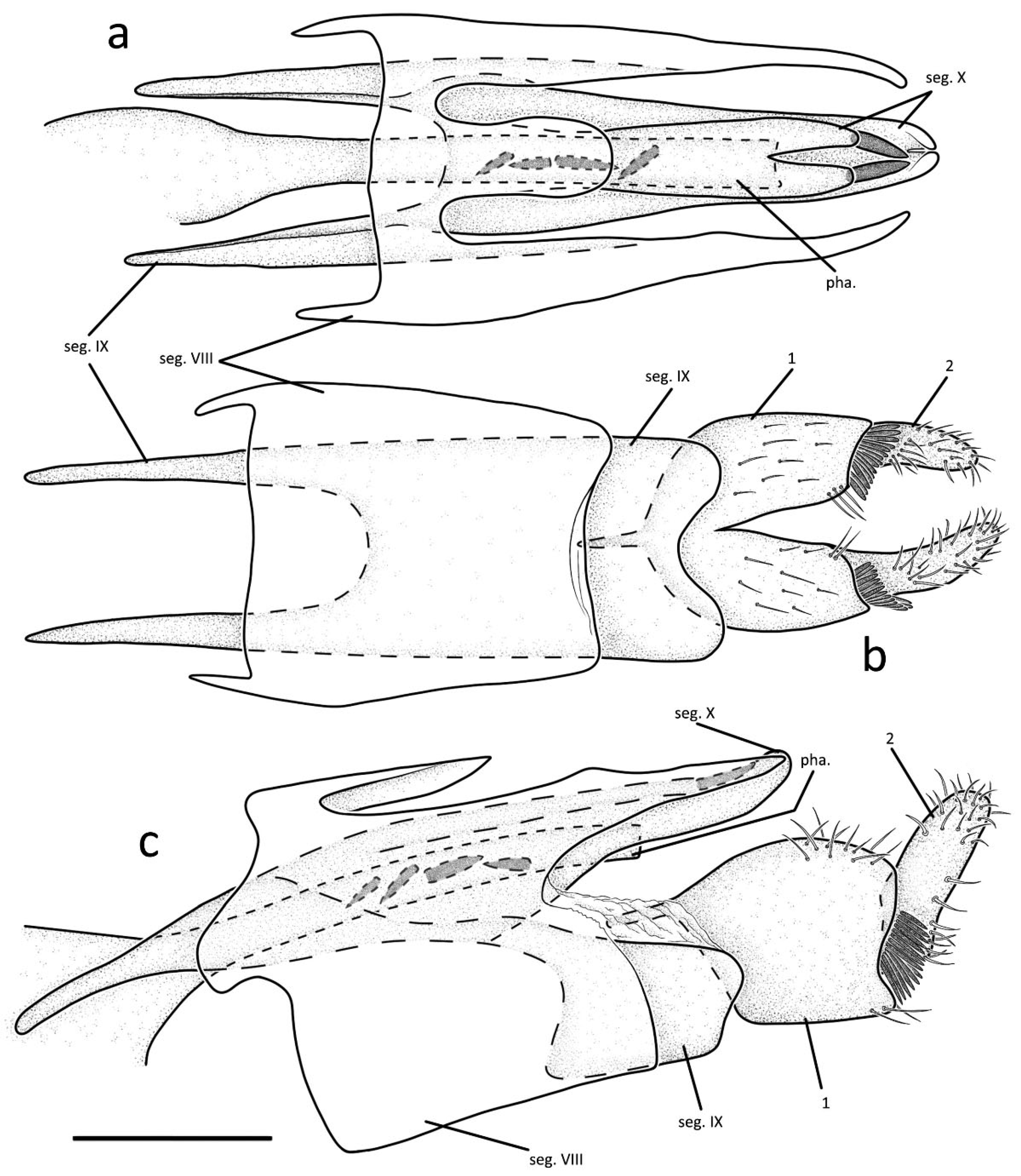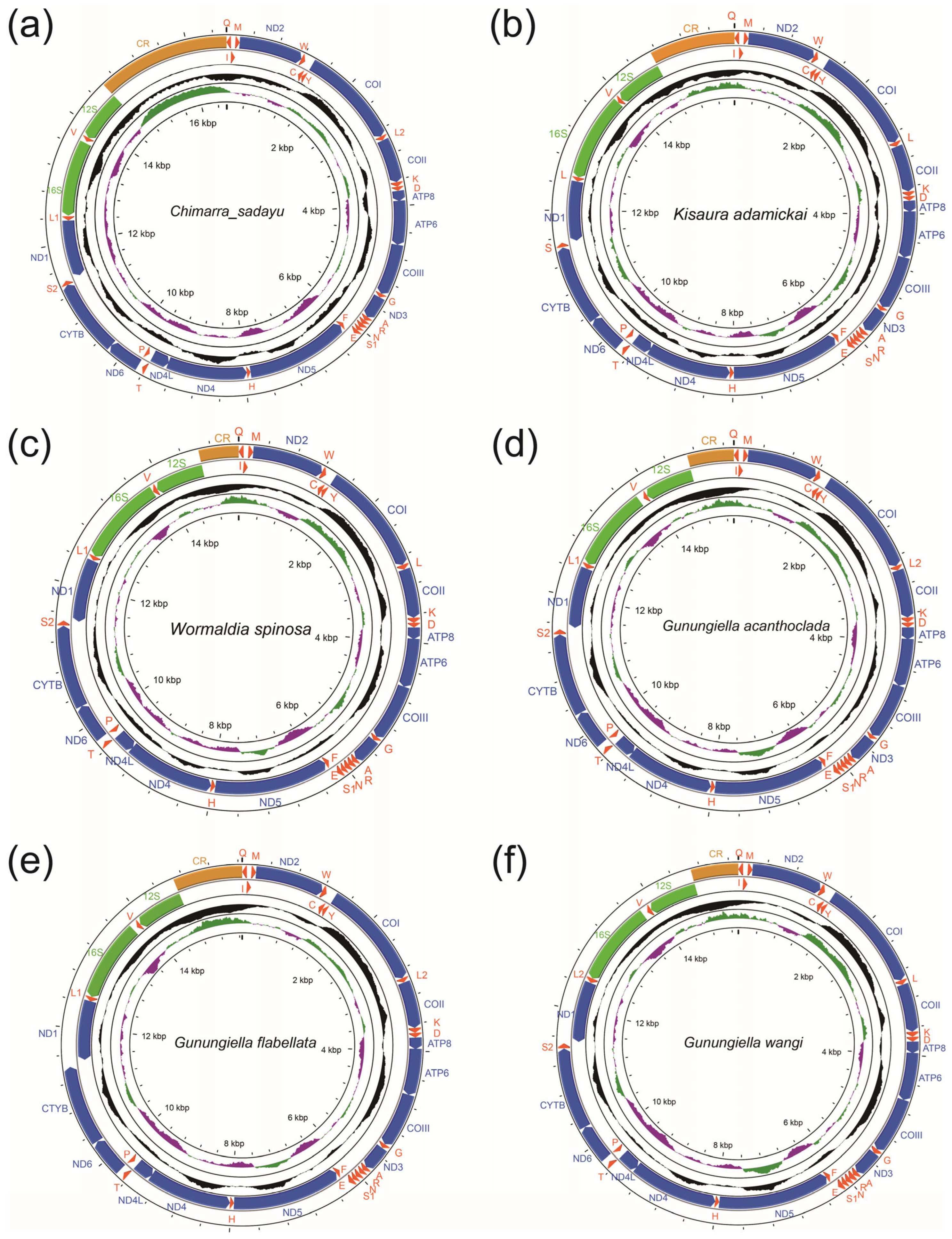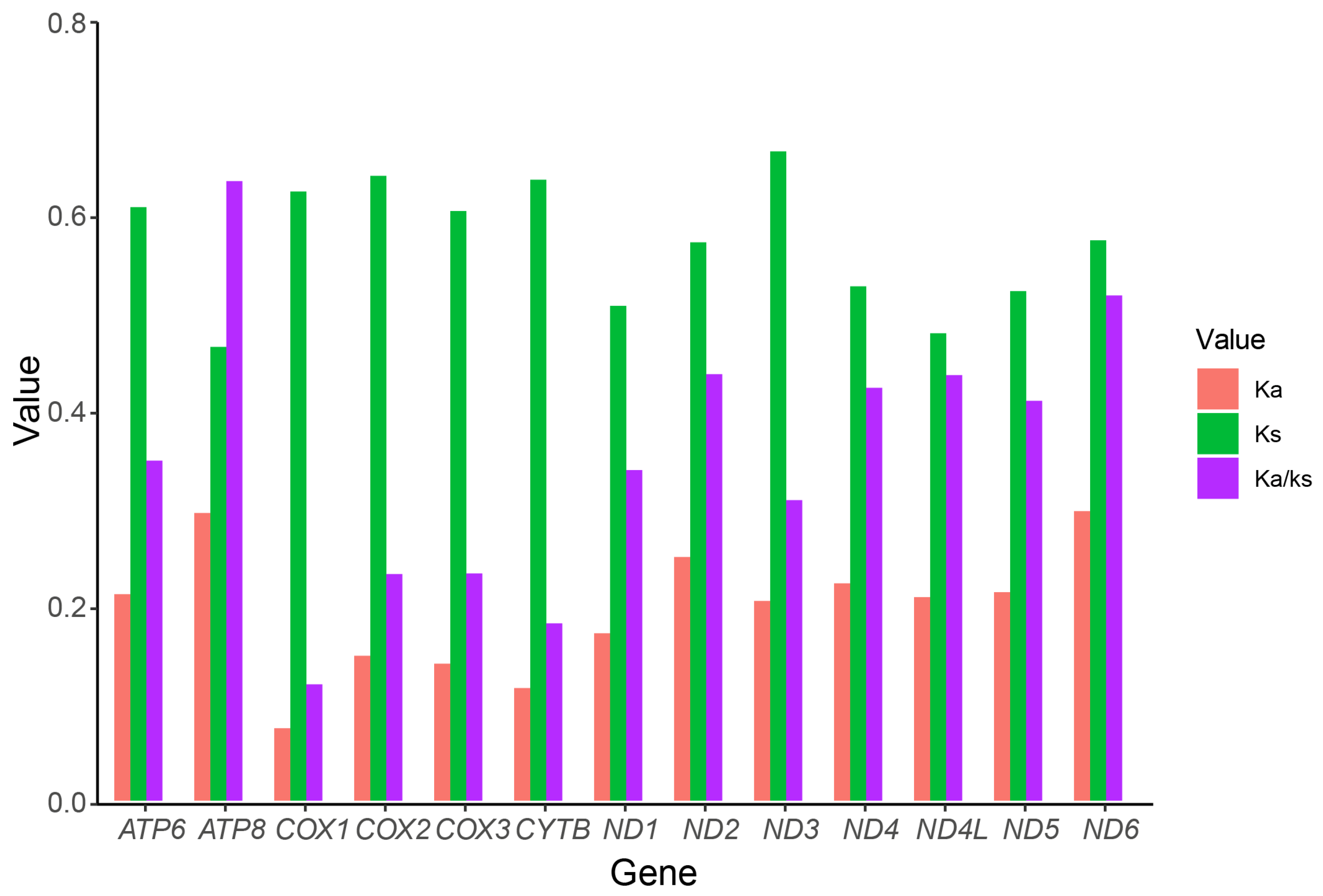New Mitogenome Features of Philopotamidae (Insecta: Trichoptera) with Two New Species of Gunungiella
Abstract
Simple Summary
Abstract
1. Introduction
2. Materials and Methods
2.1. Morphological Study
2.2. DNA Extraction, Amplification and Sequencing
2.3. Assembly, Annotation and Nucleotide Composition
2.4. Phylogenetic Analyses
3. Results
3.1. Taxonomy
3.1.1. Gunungiella wangi, Peng, Ge and Sun n. sp. (Figure 1a and Figure 2a–e)


3.1.2. Gunungiella flabellata, Peng, Ge and Sun n. sp. (Figure 1b and Figure 3a–e)

3.2. New Mitogenome Features of Philopotamidae
3.2.1. Protein Coding Genes
3.2.2. Transfer and Ribosomal RNA Genes
3.2.3. Phylogenetic Analysis
4. Discussion
4.1. Mitogenome Features
4.2. Morphology and Mitogenome Implications for the Phylogenetic Position of Gunungiella
5. Conclusions
Supplementary Materials
Author Contributions
Funding
Data Availability Statement
Acknowledgments
Conflicts of Interest
References
- Morse, J.C. Trichoptera World Checklist. Available online: http://entweb.clemson.edu/database/trichopt/index.htm (accessed on 21 June 2022).
- Schmid, F. Le genre Gunungiella Ulmer (Trichoptères: Philopotamides). Can. Entomol. 1968, 100, 897–957. [Google Scholar] [CrossRef]
- Ulmer, G. Über einige von Edw. Jacobson auf Java gesammelte Trichopteren. Notes Leyden Mus. 1913, 35, 78–101. [Google Scholar]
- Oláh, J.; Malicky, H. Caddisflies (Trichoptera) from Sumatra (Indonesia), with descriptions of eleven new species. Braueria 2011, 38, 15–22. [Google Scholar]
- Malicky, H. Neue Trichopteren aus Europa und Asien. Braueria 2011, 38, 23–43. [Google Scholar]
- Schmid, F. Les Trichoptères de la collection Navas. Eos Rev. Española De Entomol. 1949, 25, 305–426. [Google Scholar]
- Huisman, J. New species of Gunungiella (Trichoptera: Philopotamidae) from Sabah, East Malaysia. Zool. Meded. 1993, 67, 75–89. [Google Scholar]
- Malicky, H. Weitere neue Köcherfliegen (Trichoptera) aus Asien. Braueria 1995, 22, 11–26. [Google Scholar]
- Melnitsky, S.I.; Ivanov, V.D. New species of the family Philopotamidae (Insecta: Trichoptera) from Malaysia and Indonesia. Proc. Zool. Inst. Russ. Acad. Sci. 2010, 314, 323–332. [Google Scholar] [CrossRef]
- Malicky, H.; Chantaramongkol, P. Neue Trichopteren aus Thailand. Teil 1: Rhyacophilidae, Hydrobiosidae, Philopotamidae, Polycentropodidae, Ecnomidae, Psychomyidae, Arctopsychidae, Hydropsychidae. Linz. Biol. Beiträge 1993, 25, 433–487. [Google Scholar]
- Malicky, H.; Chantaramongkol, P. Neue Trichopteren aus Thailand. Teil 2: Rhyacophilidae, Philopotamidae, Polycentropodidae, Ecnomidae, Psychomyiidae, Xiphocentronidae, Helicopsychidae, Odontoceridae. Linz. Biol. Beiträge 1993, 25, 1137–1187. [Google Scholar]
- Malicky, H.; Chantaramongkol, P. Vierzehn neue Köcherfliegen aus Thailand (Insecta, Trichoptera). (35. Arbeit über thailändische Köcherfliegen). Linz. Biol. Beiträge 2003, 35, 915–925. [Google Scholar]
- Malicky, H. Beiträge zur Kenntnis asiatischer Trichopteren. Braueria 2009, 36, 11–58. [Google Scholar]
- Malicky, H.; Prommi, T. Beschreibungen einiger Köcherfliegen aus Süd-Thailand (Trichoptera). Linz. Biol. Beiträge 2006, 38, 1591–1608. [Google Scholar]
- Ulmer, G. Trichopteren von den Philippinen und von den Sunda-Inseln. Treubia 1930, 11, 373–497. [Google Scholar]
- Banks, N. Neuropteroid insects from the Philippines. Philipp. J. Crop Sci. 1939, 69, 133–145. [Google Scholar]
- Malicky, H. Neue asiatische Köcherfliegen (Trichoptera: Rhyacophilidae, Philopotamidae, Ecnomidae und Polycentropodidae). Entomol. Ber. Luzern 1993, 29, 77–88. [Google Scholar]
- Mey, W. Contribution to the Knowledge of the caddisflies of the Philippines. 1. (Trichoptera). Dtsch. Entomol. Z. 1995, 42, 191–209. [Google Scholar] [CrossRef]
- Mey, W. Contribution to the knowledge of the caddisflies of the Philippines. 2. the species of the Mt. Agtuuganon Range on Mindanao (Insecta: Trichoptera). Nachr. Des Entomol. Ver. Apollo Suppl. 1998, 17, 537–576. [Google Scholar]
- Mey, W. Contribution to the knowledge of the caddisfly fauna of the Philippines, III (Insecta: Trichoptera). Entomofauna 1998, 19, 1–32. [Google Scholar]
- Mey, W. Contribution to the knowledge of the caddisfly fauna of the Philippines, V (Insecta, Trichoptera). Insecta Koreana 2003, 20, 425–452. [Google Scholar]
- Malicky, H. Köcherfliegen (Trichoptera) von Java und Sumatra, mit Revision einiger Ulmer-Typen aus dem Hamburger Museum. Linz. Biol. Beiträge 1998, 30, 795–814. [Google Scholar]
- Malicky, H. Neue Köcherfliegen aus Europa und Asien. Braueria 2004, 31, 36–42. [Google Scholar]
- Malicky, H. Neue Köcherfliegen (Trichoptera, Insecta) aus Vietnam. Linz. Biol. Beiträge 1995, 27, 851–885. [Google Scholar]
- Oláh, J.; Malicky, H. New species and new species records of Trichoptera from Vietnam. Braueria 2010, 37, 13–42. [Google Scholar]
- Sun, C.-H.; Gui, F.-R.; Yang, L.-F. Five new species of Philopotamidae (Trichoptera) from Yunnan, China. Kun Chong fen lei xue bao=Entomotaxonomia 2001, 23, 193–200. [Google Scholar]
- Sun, C.-h. Two new species of Philopotamidae (Insecta: Trichoptera) from China. J. Nanjing Agric. Univ. 2007, 30, 71–73. [Google Scholar]
- Banks, N. New neuropteroid insects. Bull. Mus. Comp. Zool. Harv. 1920, 64, 299–362. [Google Scholar]
- Schmid, F. Trichoptères de Ceylan. Arch. Für Hydrobiol. 1958, 54, 1–173. [Google Scholar]
- Chantaramongkol, P.; Malicky, H. Beschreibung von neuen Köcherfliegen (Trichoptera, Insecta) aus Sri Lanka. Ann. Des Nat. Mus. Wien. Ser. B Für Bot. Und Zool. 1984, 88, 511–534. [Google Scholar]
- Schmid, F. Trichoptères du Pakistan III. Tijdschr. Voor Entomol. 1960, 103, 83–109. [Google Scholar]
- Zhang, G.K.; Chain, F.; Abbott, C.L.; Cristescu, M.E. Metabarcoding using multiplexed markers increases species detection in complex zooplankton communities. Evol. Appl. 2018, 11, 1901–1914. [Google Scholar] [CrossRef]
- Ge, X.Y.; Zang, H.; Ye, X.; Peng, L.; Wang, B.; Lian, G.; Sun, C. Comparative Mitogenomic Analyses of Hydropsychidae Revealing the Novel Rearrangement of Protein-Coding Gene and tRNA (Trichoptera: Annulipalpia). Insects 2022, 13, 759. [Google Scholar] [CrossRef]
- Cameron, S.L. Insect mitochondrial genomics: Implications for evolution and phylogeny. Annu. Rev. Entomol. 2014, 59, 95–117. [Google Scholar] [CrossRef]
- Boore, J.L. Animal mitochondrial genomes. Nucleic Acids Res. 1999, 27, 1767–1780. [Google Scholar] [CrossRef]
- Korkmaz, E.M.; Doǧan, Ö.; Durel, B.S.; Temel Altun, B.; Budak, M.; Başibüyük, H.H. Mitogenome organization and evolutionary history of the subfamily Cephinae (Hymenoptera: Cephidae). Syst. Entomol. 2022, 43, 606–618. [Google Scholar] [CrossRef]
- Zheng, C.-G.; Liu, Z.; Zhao, Y.-M.; Wang, Y.; Bu, W.-J.; Wang, X.-H.; Lin, X.-L. First Report on Mitochondrial Gene Rearrangement in Non-Biting Midges, Revealing a Synapomorphy in Stenochironomus Kieffer (Diptera: Chironomidae). Insects 2022, 13, 115. [Google Scholar] [CrossRef]
- Saenz Manchola, O.F.; Virrueta Herrera, S.; D'Alessio, L.M.; Yoshizawa, K.; García Aldrete, A.N.; Johnson, K.P. Mitochondrial genomes within bark lice (Insecta: Psocodea: Psocomorpha) reveal novel gene rearrangements containing phylogenetic signal. Syst. Entomol. 2021, 46, 938–951. [Google Scholar] [CrossRef]
- Yan, L.; Pape, T.; Elgar, M.A.; Gao, Y.; Zhang, D. Evolutionary history of stomach bot flies in the light of mitogenomics. Syst. Entomol. 2019, 44, 797–809. [Google Scholar] [CrossRef]
- Lin, X.L.; Liu, Z.; Yan, L.P.; Duan, X.; Bu, W.J.; Wang, X.H.; Zheng, C.G. Mitogenomes provide new insights of evolutionary history of Boreheptagyiini and Diamesini (Diptera: Chironomidae: Diamesinae). Ecol. Evol. 2022, 12, e8957. [Google Scholar] [CrossRef]
- Liu, Y.Q.; Li, H.; Song, F.; Zhao, Y.S.; Wilson, J.J.; Cai, W.Z. Higher-level phylogeny and evolutionary history of Pentatomomorpha (Hemiptera: Heteroptera) inferred from mitochondrial genome sequences. Syst. Entomol. 2019, 44, 810–819. [Google Scholar] [CrossRef]
- Nie, R.; Vogler, A.P.; Yang, X.-K.; Lin, M. Higher-level phylogeny of longhorn beetles (Coleoptera: Chrysomeloidea) inferred from mitochondrial genomes. Syst. Entomol. 2021, 46, 56–70. [Google Scholar] [CrossRef]
- Ge, X.Y.; Peng, L.; Vogler, A.P.; Morse, J.C.; Yang, L.F.; Sun, C.H.; Wang, B.X. Massive gene rearrangements of mitochondrial genomes and implications for the phylogeny of Trichoptera (Insecta). Syst. Entomol. 2022, 1–18. [Google Scholar] [CrossRef]
- Xu, J.H. Taxonomy and Larval-Adult Associations of Chinese Stenopsychidae (Insect: Trichoptera). Master of Science Thesis, Nanjing Agricultural University, Nanjing, China, 2014; 101p. [Google Scholar]
- Heidinger, R.C. Use of ultraviolet light to increase the availability of aerial insects to caged bluegill sunfish. Progress. Fish-Culturist 1971, 33, 187–192. [Google Scholar] [CrossRef]
- Ross, H.H. Evolution and Classification of the Mountain Caddisflies; University of Illinois Press: Urbana, IL, USA, 1956; 213p. [Google Scholar]
- Zang, H.; Ge, X.; Peng, L.; Sun, C.; Wang, B. A New Species of Limnephilus (Insecta: Trichoptera: Limnephilidae) from China, with Revision of the Genus Limnephilus on the Chinese Mainland. Insects 2022, 13, 653. [Google Scholar] [CrossRef] [PubMed]
- Dierckxsens, N.; Mardulyn, P.; Smits, G. NOVOPlasty: De novo assembly of organelle genomes from whole genome data. Nucleic Acids Res. 2016, w955. [Google Scholar] [CrossRef] [PubMed]
- Donath, A.; Juhling, F.; Al-Arab, M.; Bernhart, S.H.; Reinhardt, F.; Stadler, P.F.; Middendorf, M.; Bernt, M. Improved annotation of protein-coding genes boundaries in metazoan mitochondrial genomes. Nucleic Acids Res. 2019, 47, 10543–10552. [Google Scholar] [CrossRef]
- Kearse, M.; Moir, R.; Wilson, A.; Stones-Havas, S.; Cheung, M.; Sturrock, S.; Buxton, S.; Cooper, A.; Markowitz, S.; Duran, C.; et al. Geneious Basic: An integrated and extendable desktop software platform for the organization and analysis of sequence data. Bioinformatics 2012, 28, 1647–1649. [Google Scholar] [CrossRef]
- Shen, W.; Le, S.; Li, Y.; Hu, F.Q. SeqKit: A cross-platform and ultrafast toolkit for FASTA/Q file manipulation. PLoS ONE 2016, 11, e163962. [Google Scholar] [CrossRef]
- Rozas, J.; Ferrer-Mata, A.; Sanchez-Del; Barrio, J.C.; Guirao-Rico, S.; Librado, P.; Ramos-Onsins, S.E.; Sanchez-Gracia, A. DnaSP 6: DNA sequence polymorphism analysis of large data sets. Mol. Biol. Evol. 2017, 34, 3299–3302. [Google Scholar] [CrossRef]
- Grant, J.R.; Stothard, P. The CGView Server: A comparative genomics tool for circular genomes. Nucleic Acids Res. 2008, 36 (Suppl. 2), W181–W184. [Google Scholar] [CrossRef]
- Thomas, J.A.; Frandsen, P.B.; Prendini, E.; Zhou, X.; Holzenthal, R.W. A multigene phylogeny and timeline for Trichoptera (Insecta). Syst. Entomol. 2020, 45, 670–686. [Google Scholar] [CrossRef]
- Katoh, K.; Standley, D.M. MAFFT Multiple Sequence Alignment Software Version 7: Improvements in performance and usability. Mol. Biol. Evol. 2013, 30, 772–780. [Google Scholar] [CrossRef]
- Capella-Gutierrez, S.; Silla-Martinez, J.M.; Gabaldon, T. trimAl: A tool for automated alignment trimming in large-scale phylogenetic analyses. Bioinformatics 2009, 25, 1972–1973. [Google Scholar] [CrossRef]
- Kück, P.; Longo, G.C. FASconCAT-G: Extensive functions for multiple sequence alignment preparations concerning phylogenetic studies. Front. Zool. 2014, 11, 81. [Google Scholar] [CrossRef]
- Kalyaanamoorthy, S.; Minh, B.Q.; Wong, T.K.F.; von Haeseler, A.; Jermiin, L.S. ModelFinder: Fast model selection for accurate phylogenetic estimates. Nat. Methods 2017, 14, 587–589. [Google Scholar] [CrossRef]
- Minh, B.Q.; Schmidt, H.A.; Chernomor, O.; Schrempf, D.; Woodhams, M.D.; von Haeseler, A.; Lanfear, R. IQ-TREE 2: New models and efficient methods for phylogenetic inference in the genomic era. Mol. Biol. Evol. 2020, 37, 1530–1534. [Google Scholar] [CrossRef]
- Guindon, S.; Dufayard, J.F.; Lefort, V.; Anisimova, M.; Hordijk, W.; Gascuel, O. New algorithms and methods to estimate maximum-likelihood phylogenies: Assessing the performance of PhyML 3.0. Syst. Biol. 2010, 59, 307–321. [Google Scholar] [CrossRef]
- Hoang, D.T.; Chernomor, O.; von Haeseler, A.; Minh, B.Q.; Vinh, L.S. UFBoot2: Improving the Ultrafast Bootstrap Approximation. Mol. Biol. Evol. 2018, 35, 518–522. [Google Scholar] [CrossRef]
- Wang, H.C.; Minh, B.Q.; Susko, E.; Roger, A.J. Modeling site heterogeneity with posterior mean site frequency profiles accelerates accurate phylogenomic estimation. Syst. Biol. 2017, 67, 216–235. [Google Scholar] [CrossRef]
- Lartillot, N.; Rodrigue, N.; Stubbs, D.; Richer, J. PhyloBayes MPI: Phylogenetic reconstruction with Infinite mixtures of profiles in a parallel environment. Syst. Biol. 2013, 62, 611–615. [Google Scholar] [CrossRef]
- Rambaut, A. FigTree Version 1.4.3. Computer Program Distributed by the Author. Available online: http://tree.bio.ed.ac.uk/software/figtree/ (accessed on 25 November 2018).
- Ge, X.Y.; Peng, L.; Du, J.; Sun, C.H.; Wang, B.X. New species of the genus Molanna Curtis, 1834 (Trichoptera, Molannidae) in China inferred from morphology and DNA barcodes. ZooKeys 2022, 111, 161–178. [Google Scholar] [CrossRef]
- Zheng, C.G.; Zhu, X.X.; Yan, L.P.; Yao, Y.; Lin, X.L. First complete mitogenomes of diamesinae, orthocladiinae, prodiamesinae, tanypodinae (diptera: Chironomidae) and their implication in phylogenetics. PeerJ 2021, 9, e11294. [Google Scholar] [CrossRef] [PubMed]
- Ojala, D.; Montoya, J.; Attardi, G. tRNA punctuation model of RNA processing in human mitochondria. Nature 1981, 290, 470–474. [Google Scholar] [CrossRef] [PubMed]
- Zou, H.; Jakovlić, I.; Chen, R.; Zhang, D.; Zhang, J.; Li, W.X.; Wang, G.T. The complete mitochondrial genome of parasitic nematode Camallanus cotti: Extreme discontinuity in the rate of mitogenomic architecture evolution within the Chromadorea class. BMC Genom. 2017, 18, 1–17. [Google Scholar] [CrossRef]
- Lavrov, D.V.; Pett, W. Animal Mitochondrial DNA as We Do Not Know It: Mt-Genome Organization and Evolution in Nonbilaterian Lineages. Genome Biol. Evol. 2016, 8, 2896–2913. [Google Scholar] [CrossRef]
- Duchêne, A.M.; Pujol, C.; Maréchal-Drouard, L. Import of tRNAs and aminoacyl-tRNA synthetases into mitochondria. Curr. Genet. 2009, 55, 1–18. [Google Scholar] [CrossRef]
- Wahlberg, E.; Johanson, K.A. The age, ancestral distribution and radiation of Chimarra (Trichoptera: Philopotamidae) using molecular methods. Mol. Phylogenet. Evol. 2014, 79, 433–442. [Google Scholar] [CrossRef]
- Siddall, M.E.; Whiting, M.F. Long-branch abstractions. Cladistics 1999, 15, 9–24. [Google Scholar] [CrossRef]



| Species | Number of Specimens | Collection Site | Trap Type |
|---|---|---|---|
| Chimarra sadayu (Malicky, 1993) | 1 male | Xian-xi town, Yue-qing city, Zhe-jiang | light trap |
| Kisaura adamickai (Sun and Malicky, 2002) | 1 male | Jin-xi town, Long-quan city, Zhe-jiang | light trap |
| Wormaldia spinosa (Ross, 1956) | 1 male | Xi-yang town, Yong-an city, Fu-jian | light trap |
| Gunungiella acanthoclada (Sun, 2007) | 1 male | Yi-zhang county, Chen-zhou city, Hu-nan | Malaise trap |
| Gunungiella wangi n. sp. | 1 male | Sui-ning county, Shao-yang city, Hu-nan | light trap |
| Gunungiella flabellata n. sp. | 1 male | Yi-zhang county, Chen-zhou city, Hu-nan | Malaise trap |
| Gunungiella flabellata n. sp. | 7 males | Huang-keng town, Wu-yi-shan City, Fu-jian | Malaise trap |
| Gunungiella flabellata n. sp | 1 male | Yang-zhuang town, Wu-yi-shan city, Fu-jian | light trap |
| Species | NCBI Accession | Life Stage | Collection Site | Collection Date |
|---|---|---|---|---|
| Chimarra sadayu | OP351513 | Adult (male) | Zhe-jiang | 27 May 2017 |
| Kisaura adamickai | OP351517 | Adult (male) | Zhe-jiang | 1 July 2021 |
| Wormaldia spinosa | OP351518 | Adult (male) | Fu-jian | 28 June 2021 |
| Gunungiella acanthoclada | OP351514 | Adult (male) | Hu-nan | 8–18 August 2020 |
| Gunungiella wangi n. sp. | OP351516 | Adult (male) | Hu-nan | 28 May 2021 |
| Gunungiella flabellata n. sp. | OP351515 | Adult (male) | Hu-nan | 8–18 August 2020 |
Publisher’s Note: MDPI stays neutral with regard to jurisdictional claims in published maps and institutional affiliations. |
© 2022 by the authors. Licensee MDPI, Basel, Switzerland. This article is an open access article distributed under the terms and conditions of the Creative Commons Attribution (CC BY) license (https://creativecommons.org/licenses/by/4.0/).
Share and Cite
Peng, L.; Ge, X.; Shi, F.; Wang, L.; Zang, H.; Sun, C.; Wang, B. New Mitogenome Features of Philopotamidae (Insecta: Trichoptera) with Two New Species of Gunungiella. Insects 2022, 13, 1101. https://doi.org/10.3390/insects13121101
Peng L, Ge X, Shi F, Wang L, Zang H, Sun C, Wang B. New Mitogenome Features of Philopotamidae (Insecta: Trichoptera) with Two New Species of Gunungiella. Insects. 2022; 13(12):1101. https://doi.org/10.3390/insects13121101
Chicago/Turabian StylePeng, Lang, Xinyu Ge, Faxian Shi, Le Wang, Haoming Zang, Changhai Sun, and Beixin Wang. 2022. "New Mitogenome Features of Philopotamidae (Insecta: Trichoptera) with Two New Species of Gunungiella" Insects 13, no. 12: 1101. https://doi.org/10.3390/insects13121101
APA StylePeng, L., Ge, X., Shi, F., Wang, L., Zang, H., Sun, C., & Wang, B. (2022). New Mitogenome Features of Philopotamidae (Insecta: Trichoptera) with Two New Species of Gunungiella. Insects, 13(12), 1101. https://doi.org/10.3390/insects13121101







